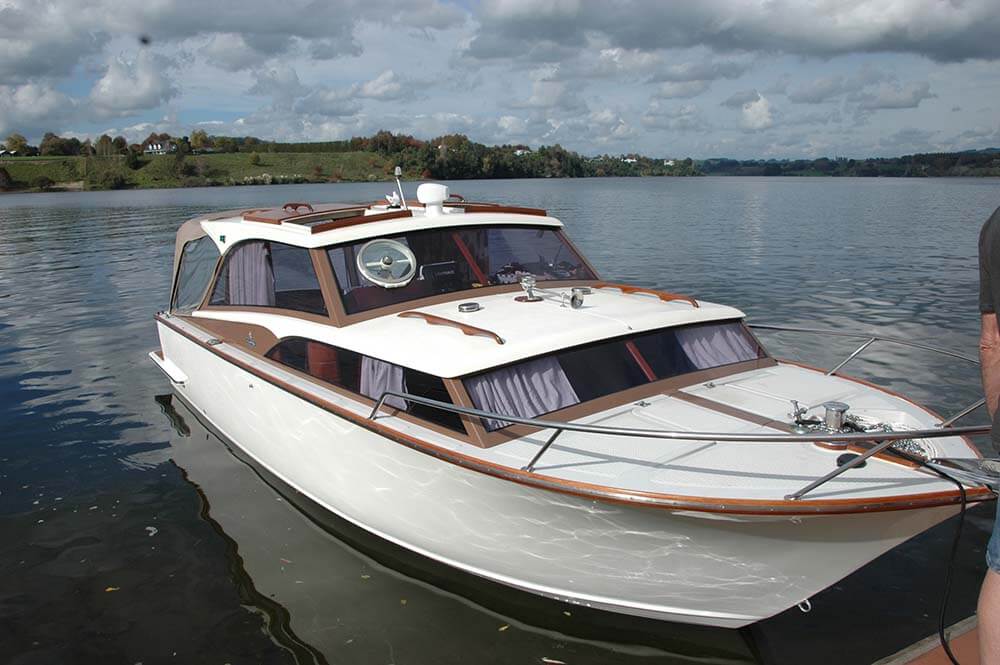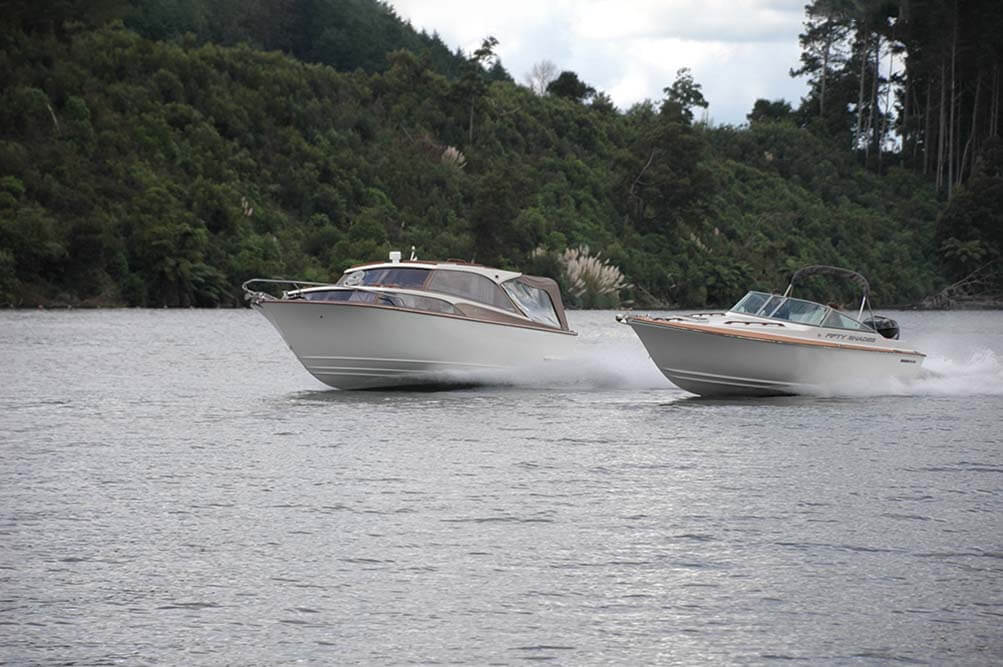MASON CLIPPER
An advert in the 1960s edition of Sea Spray magazine read: The world’s finest power boat- for those people in the position to demand it. The advert said, Whoever said there was no such thing as the perfect boat, obviously never owned a Clipper. If there was ever a Kiwi boat brand that defined Kiwi trailer boating at its very best, it has to be the Mason Marine Clipper.
In its day, it was the most expensive trailer boat on the market, and people didn’t mind paying for it. Undoubtedly the most luxurious and outstanding boat in its class, the Clipper 24 epitomised the elite end of trailer boating. The Tony Mason-designed Clipper 24 was a fast cruiser, a true weekender in every sense, and the layout was sumptuous by the day’s standards. Then as now, quality and class don’t come cheaply, and in 1977, a hull alone was $20,000, and a complete boat package would set you back around $30,000. That same year, a Cresta Craft V19, Fi Glass Viscount or Morgan 6.3 could be put on the water fully spec’d for around $13,000. Plus, you needed a reasonably large car because it had a towing weight of 2500- 2700 kg. Remembering this was pre SUVs and crew cab utes, so a popular choice was the Mk10, later the XJ6 Jaguar or Chev Impala. But you got the quintessential luxury trailer boat that was a league above everything else. Owning a Clipper was a status symbol, and many well-known Kiwis had one in their driveway. The Clipper looked different from everything else and was one of the earliest production trailerable weekenders.
BIRTH OF THE CLIPPER
In 1951 Tony and his old Airforce buddy Cliff Sutton started Sutton Mason Ltd selling household detergent. Then a year later, they turned to boat building with Tony’s new Marlin series of runabouts from their Stoddard Rd Mt Roskill Auckland factory. The very first Marlin ever built was a 17-footer powered by twin Ford 10 engines and was launched in 1952. Over the next seven years, Marlin powerboats were produced in great numbers and became one of the better selling trailer boats of the post-war era. In 1957 Tony sold his interest in Sutton Mason Ltd and returned to the Airforce for a short time before forming Mason Marine Clippers in late 1959. Mason Marine started in mid-1959 in Mt Eden before moving to Archers Rd Takapuna when the Auckland Harbour Bridge opened. In 1960 the first strip- planked cedar/fibreglass Clipper 23, Geo, came out of the new Wairau Road factory. Tony admits he was influenced by Ray Hunt with his revolutionary’ deep vee’ hull form and Lindsay Lord’s monohedron hull shapes and composite construction. In an interview in 1984 in NZ Powerboat magazine, Tony said,” I was beginning to believe that it was not just the prop size, the hull shape or the size of the motor that made a good boat, it was the balance of all three”. Geo was built for cruising and fishing throughout the Hauraki Gulf. It was a standard small window Clipper 23ft powered by the Graymarine Fireball V8 rated at 188hp running through a Warner Velvet Drive Hydraulic gearbox. In their day, Clippers were a work of art and considered one of the finest built boats in the country. The Mason Marine reputation was born and reinforced when he was awarded the Industrial Design Award for |his boat designs. However, everything changed by the mid- 1960s when fibreglass-reinforced plastic (GRP) found its way into boat building. The day of the wooden production boat was all but over, so Tony had to hang up the hammer and chisel and enter the world of gel coats and resins. The first full ‘glass’ Clipper 24 was produced in 1974. As much as Tony loved building timber boats, he needed to change with the times or be left behind.
CLASS OF ITS OWN
The Clipper was in a class of its own and stayed there for many years until the advent of the larger all-fibreglass production cruisers such as the early Marklines. When the last of the Clipper 24s was built by Mason Marine in Auckland in 1980, there were 103 on the water.

Built in GRP, the first ‘glass’ Clipper was launched in 1967. Before that, apart from the hull, the cabin tops, decks and coamings were all timber and ply. With the advent of the GRP version, production increased dramatically from the North Shore factory, but not at the expense of the quality and high finish associated with the boat. No expense was spared to maintain the highest standards, from the hull laminate to the many coats of varnish on the mahogany bulkheads. The Clipper 24 was based on a round bilge 24 deg deep V hull that gave a soft ride and nice re-entry in a seaway. Power options were many, from Chrysler or Volvo sterndrives, twin outboards and even jet units. A 360ci Chrysler/Volvo 280 leg was right for 40mph, and twin Volvo 130s gave a top speed of around 35mph. While V8 sterndrives were the most popular, when the V6 outboard hit the market, the opportunity to provide even more cockpit space was available. However, few outboard versions were built as they had to be twin rigs to get sufficient weight to keep the hull deep enough in the water to be stable at rest. Besides, the maximum shaft length for an outboard in those days was 20 inches, so a single outboard was out of the question, as the powerhead would have been too close to the water.
CLIPPER 42
An enquiry from the USA for a 45-footer (13.7m) led to preliminary design work on the larger boat, but when the deal fell through, Tony decided to go ahead anyway. Surprisingly only two were ever built (Alibi and Crescendo), and both are still in use today. The Clipper 42 was as outstanding and eye-catching as the Clipper 24. Alibi is currently in the final stages of a complete refurbishment by Sandspit based Greg Lees Boat Builder. They have lovingly restored this fine lady to its former glory, which looks stunning. It was, in essence, a Clipper 24 on steroids and it gave Tony another dimension to expand his design talents. Released in 1979, the Clipper 42 was 12.8m x 3.7m with a draft of 900mm and fully laden, displaced around 9 tonnes. Alibi was the prototype, built with a sandwich construction of strip-planked Cedar, fibreglassed on both sides. A mould was taken off the prototype so that all future boats could be full GRP with a balsa core. However, Crescendo was the only boat ever pulled from the mould. As was a trademark of all Mason Clippers, the timberwork inside was all mahogany joinery and ply, and the cabin lining was a specially made padded vinyl. The Clipper 42 Alibi is still powered by the original pair of Chrysler-Mitsubishi CN-55TI diesel engines producing 200hp @ 3150 rpm. All this power goes through Warner gearboxes and Stern Power outdrives. The top speed is around 22 knots.
LET’S GO RACING
As the founding father of offshore powerboat racing in New Zealand, it was inevitable that Tony would design an offshore racing Clipper. This came in 1971 with the Clipper 26SR, Clipper Commander. Powered initially with triple V4 Johnson outboards, it looked the part but continually retired from races with the outside lower units destroyed. The 26SR featured the same rounded chine styling of the Clipper 24 but was a completely different hull. The deadrise was increased from 23 deg to 24 deg, the beam decreased from 8ft to 7ft, and the moulded hull length went from 24ft 6in to 26ft. Designed primarily as an offshore race boat, the 26SR was suitable for twin sterndrive or twin/triple outboard power. Built only to special order, the 26SR was the only stock fibreglass racing/sports hull of its size in the country. It did, however, have a timber deck. Clipper Commander was the cedar plug for all the Clipper 26SRs that followed, and surprisingly there were only six built.

Most are still around today and, while not racing anymore, have been turned into fast eye- turning pleasure boats. Mason Marine closed their doors in 1984, one of the many boat builders that could not survive Muldoons 20% boat tax introduced in the 1979 Budget. Tony closed up shop and the moulds were retired. Over the years, around a dozen Clipper models and over 200 boats were built, including the 26, 33, 36 and 42 footers. When Mason Marone closed its doors, all the moulds, apart from the 26SR, were taken to a farm, crushed and buried. The n26SR mould still exists today in Taumaranui. Today there is a resurgence of interest in the Clipper, and as quickly as they appear on the market, they get sold. Many are lovingly restored and brought back to their original finery. It is common to hear that the new owners restrict their Clipper to freshwater use only.
RACING DYNASTY
The second SR26 built was for Max Johnson in 1973, who bolted triple Mercury 150s (the most powerful you could buy) on his bright red boat he called Clipper Comsec. This was one of the most successful race boats of its time and I had the chance to have a run in it on Auckland Harbour prior to an Auckland race. Low deckline and big bolster seats meant from the waist up you were exposed, something that you wouldn’t even contemplate today. Top speed was around 70-73 mph. After going through a few owners and racing for a while as Tuxedo Junction and Clipper Cosmos with twin outboards, it has been fully restored and given a fantastic new cabin line with luxury appointments as a day cruiser and weekender. Back under the Clipper Comsec name and now in white livery it resides in Tauranga with a couple of Yamaha 200s on the transom. In December 1974, Tom and Horace Manville took delivery of ‘Clipper Black Jack’ the third SR26 built. Powered firstly by twin Volvo inline six-cylinder petrol engine’s through Volvo 270 Drive’s and then later V8 small block Fords. After a successful racing career, the boat was unfortunately destroyed in a factory fire in 1977. Morrie Begley purchased Hull #4 in early 1975, who also went down the twin Volvo power path. Racing as ‘Çlipper Go Go’ in B Class then as ‘Miss Trailways’ also in B Class it was repowered with twin Ford V8s (ex Manville Brother’s BlackJack) and raced in A Class as ‘Miss Lees’ and finally as ‘Clipper Crichton Ford’ winning the NZ Off Shore Championship in 78/79 and 79/80. Hull #5 was probably the most unusual as it was a very cut down SR26 hull that raced as Super Cryzol by Stan Ash. Power was a single Mercury outboard and it ran with some success in C Class. Not sure what happened to the boat or where it is now. While the first five SR26s all ended up on the offshore racing circuit, the last two were built for firstly John Spencer in 1980 (Man O War/ 2 x BMW sterndrives) and in 1983 Peter Spencer had boatbuilder Pete Sowman produce the last ever SR26 and named it Jaws. By this time Mason Marine had closed, but the mould was still around and in great shape to create another hull. Original power was a pair of Yamaha Precision Blend 140s. This is now owned by Greg Dutton (DMW Trailers) who has restored and repowered it with a Mercury 275. The SR26 certainly belongs in the same classic niche as the Clipper 24 and it is great to see that there are still five examples still being used and enjoyed.




